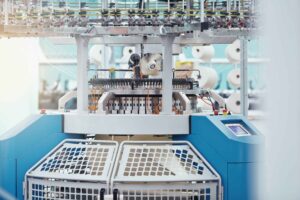Improving Productivity of Spinning Mill
The key factors affecting the productivity have been analysed, a detailed action plan prepared and implemented.
The performance of the spinning mill have been fluctuating widely due to volatility in input prices and currency fluctuations following the 2008 financial crisis. Units with higher productivity fared better than the units achieving lower productivity. This article discusses authors’ hands-on experience of improving productivity of a spinning mill in SEA (South East Asia) to the tune of 30 per cent and the impact on the overall performance of the unit. A relatively modern spinning mill equipped with auto doffing in ring frames and latest autoconers with a capacity of 64,000 spindles have been producing 1,054 tonne per month (average Ne 23) and product-mix is equally divided between carded and combed.
The production is increased to 1,402 tons per month with in 24 months of implementing an intervention programme. The key factors affecting the productivity have been analysed, a detailed action plan prepared and implemented. The area of focus is on: maintenance management practices, process parameters adjustment, fine tuning of all process machinery, training and development of operators and staff, quality management, and developing KPI (key performance indicators) for increasing accountability
Maintenance management practices
The mill had a robust maintenance plan, but never been followed in practice. The routine and preventive maintenance were regularly skipped and spare parts replacement have been sporadic and the unit staff presumed the productivity achieved is highest and can’t be improved. The spindles and rings had exceeded their useful life leading to reduced production per unit. The cost-benefit analysis was developed and demonstrated to the team and management, and sample sets were ordered and proved that the speeds can be increased significantly. The routine and preventive practices from cleaning to regular resetting were followed strictly under the supervision of consultant’s team. Measures taker under maintenance management system ensured increased production, lower end breakages in ringframe and cuts in autoconer.

Process parameters adjustment
Cotton quality parameters tend to vary from lot to lot and between bales. Fixed set of process parameters can’t be employed for varying fibre quality. Process parameters needs to be adjusted periodically to process the given fibre quality. Speeds and settings were adjusted after a quick trial and adopted across the mill whenever the fibre lot was changed. These measures ensured yarn quality is maintained within acceptable limits between lots.
Fine-tuning of all process machinery
Process machines were tuned based on AFIS (advanced fibre information system from USTER) in preparatory and individual spindles in speed frame and ring frame were immediately checked and conditions restored. The periodical checking based on AFIS and individual spindles put in place to improve performance consistency.
Training and development of Operators
The unit had no training department in place and the operators and staff continued to adopt old practices. Trainers to train the Operators, training and development department and periodic training once in three months were put in place for operators. Staff were trained on maintenance, quality, production and utility management practices and SOPs issued. KPIs were developed and staff were trained to monitor and discuss on a daily and weekly basis. Review meetings were held in Promoter’s presence on a monthly basis.
Quality management
The best practice is to ensure periodical checking of quality at every stage of the process with clear guidelines issued for go and no-go limits. Any abnormality in the process was arrested at the early stage rather than taking ad-hoc measures after the final stage. A comprehensive Quality Plan was developed and authority was given to the front line quality Operators to decide either to allow or stop the process. This single action ensured the performance of the unit improved significantly.
KPIs for increasing accountability
The unit had a culture of everyone is responsible but no one is accountable. KPIs were developed with standards for spindle point production, utilisation, quality, yarn realisation, power consumption per kilogram of yarn produced, man power employed per 1,000 spindles and manufacturing cost per kilogram of yarn. Every individual was assigned responsibility and held accountable, performance incentive linked to the results. After a year of close follow-up, the performance culture was set in.
Prodn: Ne 23s to 30 days/month (MT)
[/vc_column_text][vc_single_image image=”6810″ img_size=”medium”][/vc_column][/vc_row]
Production Improvement %
[/vc_column_text][vc_single_image image=”6822″ img_size=”medium”]
23s Carded – Total IPI
[/vc_column_text][vc_single_image image=”6827″ img_size=”medium”]
Yarn Clearer Cuts/100 KM
[/vc_column_text][vc_single_image image=”6829″ img_size=”medium”]
Total Production Cost/KG -USD
[/vc_column_text][vc_single_image image=”6831″ img_size=”medium”][/vc_column][/vc_row]
Conclusion & Result
It is imperative for spinning units to adopt best practices on various key areas of focus to achieve industry standard productivity to ensure manufacturing cost per KG is competitive enough to sustain performance.
[/vc_column_text]
Table: 1 Results
|
SNO |
Parameters |
Beginning of the program |
After 24 months |
|
1 |
Production per month in tons |
1052 |
1402 |
|
2 |
Quality IPI – Ne 23 carded |
220 |
163 |
|
3 |
Autoconer cuts per 100 KM |
110 |
70 |
|
4 |
Manufacturing cost per KG USD |
0.85 |
0.68 |
- Production & Productivity grew by 30% in 2 years
- Quality – Yarn Imperfections reduced by 35%, Yarn Clearer-cuts came down by 57% (for the same Clearer-settings)
- Production Cost reduced by 25% – from 0.85 USD / Kg to 0.68 USD




